
Hanoi traffic
Over the last three weeks, Rosie and I have spent a lot of time in Vietnamese places beginning with the letter ‘h’: Halong Bay, Hué, Hoi An, Ho Chi Minh City. But for us, Vietnam began with The Big H – the capital city Hanoi, where we landed on 28th May.
The first thing we had to learn in Hanoi, as a matter of some urgency, was how to cross the road. ‘Mirror, signal, position, manoeuvre’; that’s what I remember from my driving lessons all those years ago. Well, in Vietnam – and in Hanoi in particular – things are slightly different. The advice given to motorists here seems to be something like: ‘honk, honk, honk, manoeuvre, then honk again, just to be on the safe side’.
There’s roughly one scooter per person in Hanoi, and at rush hour (and at other times of day for that matter) the traffic rattles along in a seemingly never-ending, chaotic stream, with scant regard for pedestrian crossings, traffic lights or any of the other niceties of Western motoring.
Crossing the road involves walking slowly, but confidently, into the traffic . No matter how narrow the street, you have to divide it into imaginary lanes and cross one stage at a time, all the while maintaining eye contact with the scooter riders, cyclists and motorists who are bearing down on you. And it’s not just foreigners who have problems crossing the road either. On our first day in Hanoi three young Vietnamese girls lined up beside me and crossed the road in my shelter, giggling nervously when we reached the other side in one piece. (Perhaps they were visiting from the countryside.)
In a strange way Hanoi reminded me of the Sicilian capital Palermo. For a start there were the scooters which were everywhere, sneaking up on you in the narrowest of alleyways and clustering untidily on the pavements. Then there was the layout of the city itself, with its French colonial architecture, its balconies and squares, and its miles of market stalls selling fresh produce. There was the Italian-style driving, of course, and, to top it all, there was a Catholic Cathedral near our guesthouse, with bells that sounded a deathly peal on the hour.
Slightly more Vietnamese are the pagodas on Hoan Kiem Lake in the centre of town. Legend has it that in the 15th Century the Vietnamese King Le Thai To defeated the invading Chinese with a sword lent to him by the gods. Having scored this victory, the sword was taken from the king by a golden tortoise which, in a rather Arthurian moment, swam with it into the lake and disappeared. Today, on an island in the lake is Tortoise Tower, a tiny fortified pagoda. On a slightly larger island to the north of the lake is Ngoc Song Temple, which is connected to the mainland by a bridge. The temple houses a shrine to the famous hero-king along with the preserved remains of a pretty big tortoise which may or may not have lived in the lake.

Inside the Temple of Literature
On another day, we took a walk up to Van Mieu, the Temple of Literature. This isn’t actually a library, as the name might suggest, but a series of interlinked pagodas begun in the 11th Century and extended and rebuilt ever since. It was also the country’s first university and, as such, is a symbol of national pride, with displays on, and shrines to the kings associated with its heyday. On a quiet day, Van Mieu would, I’m sure, be a place for quiet contemplation away from the noise of the city. On the day that we passed through however, a huge group of Young Pioneers was also visiting. The children were good-natured but noisy, chatting among themselves and shouting out “hello, hello” when we walked past.
‘Hello’ seems to be the one foreign word that all Vietnamese children know. The Vietnamese may drink coffee and eat baguettes, but the French language seems to have all but died out in the country, much to the chagrin, I’m sure, of the Institute Française, which is still very active here. Only the old, who were educated under the colonial system seem to speak French; elsewhere, it’s English all the way. Children in school learn English, people who work in the tourist industry speak English, and menus are in Vietnamese and English. It was all a little bit embarrassing for us, in a convenient kind of way.
In fact, being in Asia, I’ve really started to appreciate the power that English is gaining these days as a global lingua franca. Regional broadcasters from Japan, China and elsewhere screen English language TV programmes, there are English language newspapers printed everywhere from Bangkok to Hanoi to Tokyo and, more than once, I’ve heard Asians of different nationalities use English to communicate with one another.
Is this a good thing? I’m sure that lots of people (especially the French) would say no. And in a sense, English is a bit like the McDonald’s of languages, popping up everywhere and making the world a less diverse, exciting place. But, on the other hand, unless we all start speaking Esperanto, then surely some languages will inevitably gain the upper hand over others, for everyone’s convenience. Anyway, I’ll let greater minds than mine puzzle this one out…
Going back to Hanoi for a moment, let me tell you a little bit the Ho Chi Minh Mausoleum, which Rosie and I tried – and failed – to visit. 40 years after his death, ‘Uncle Ho’ is still everywhere in Vietnam: a friendly, avuncular face smiling up from bank notes, political posters and portraits in buildings public and private. When he died, his body was preserved Lenin-style, by being pumped full of chemicals so that it could be viewed by future generations. We turned up at the mausoleum – an impressive block of granite surrounded by soldiers and a huge public square – to find it closed. Apparently once a year Uncle Ho is shipped off the Moscow for ‘essential maintenance work’, so we can only assume that’s where he was.
Another very touristy thing that we did was to go and watch some traditional Vietnamese water puppetry at the Water Puppetry Theatre (where else?) in central Hanoi. This form of puppetry developed in the rural north where, after the yearly harvest, the empty rice paddies would be used as big outdoor stages. From behind a curtain the puppeteers, waist-deep in water, act out traditional stories using puppets controlled from below the surface of the water. Meanwhile, a band plays music and sings. The stories we saw reflected age-old rural concerns – how to keep a fox away from your ducks for example – as well as being by turns comedic (a man trying to catch a fish, but catching his wife) and historic (a re-telling of the legend of Le Thai To and the tortoise). I enjoyed it a lot, as did the little boy a few rows ahead bouncing and waving his arms in time to the music, and the old man behind us who broke into song every few minutes.

If it's in a museum, it can't be rude... Carvings at The Museum of Ethnography in Hanoi.
Hanoi then: I could write a lot more about it and I could have spent a lot longer there. It’s the kind of city where you’re always discovering new things, where a walk around the block or a trip across the road is an adventure in itself, where the people are friendly, the food tasty and the beer cheap (but a little too gassy).
Cam on, goodnight, and tam biet, as they say around these parts.
I went to the mausoleum, it’s a shame you couldn’t go as it is an experience. The man himself looks extremely well preserved – whether that’s from his annual jaunts to Moscow or some other reason (ie being blatantly made out of wax) – well I couldn’t possibly comment! The real eye-opener is people’s reactions to the experience though, whether that’s the incredible heavy-handedness of the guards as they rush you through or the way that the old ladies do that ‘worshipping’ gesture towards him that they do in temples….
I am going to visit Hanoi, to experience what you have told us in your blog
Thank you